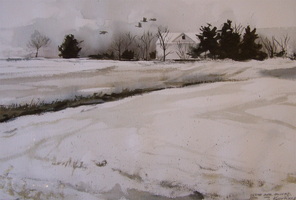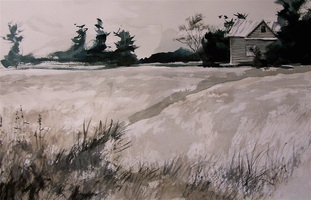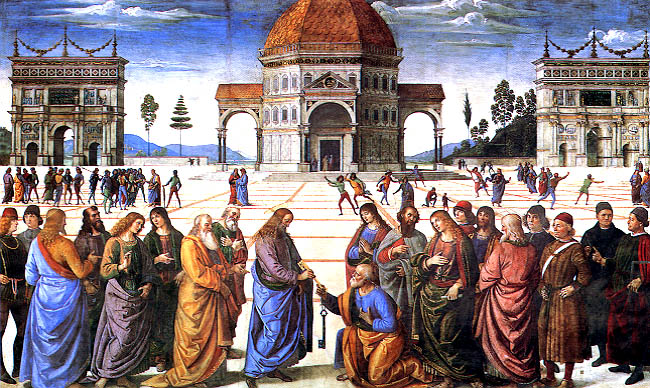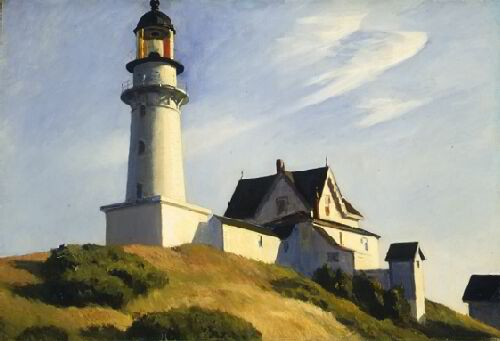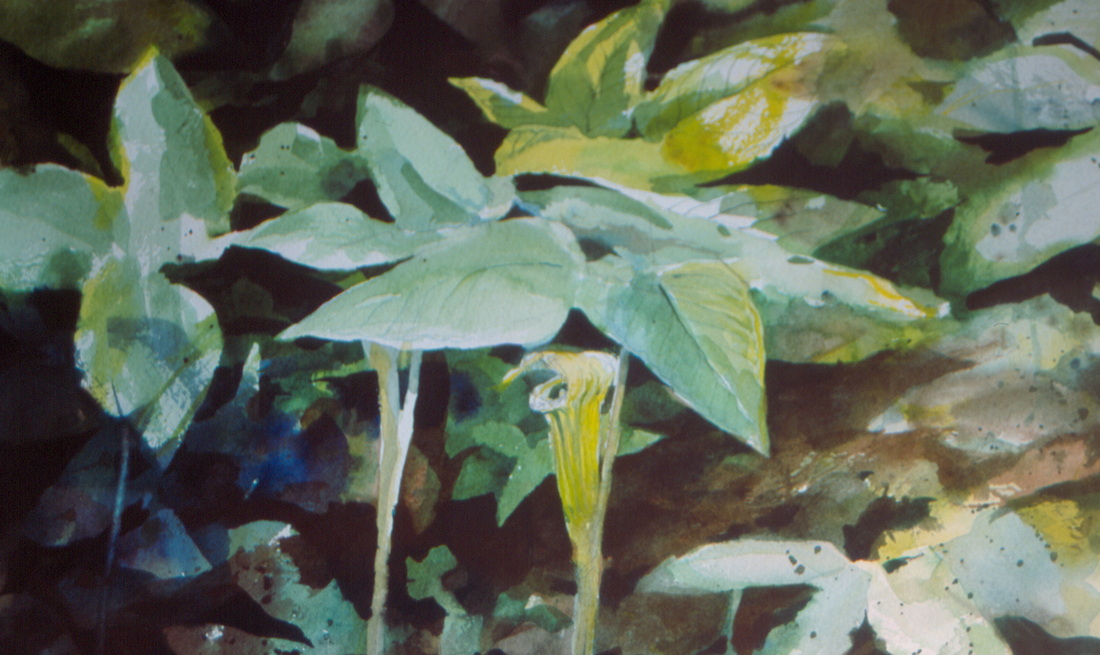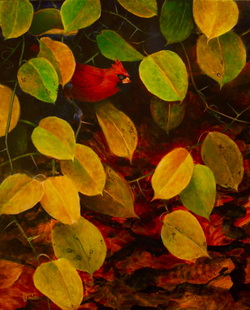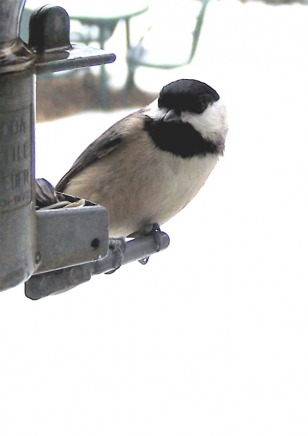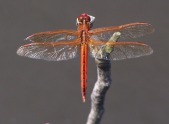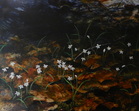| Kurt Plinke, Artist and Naturalist |
Between the Waters
life, Art and The Nature of things Between the Atlantic and the Chesapeake
|
First, I have to say that I found a wonderful website, devoted to animal and plant identification. I was looking for information about the Carbonated Swamp Warbler, one of those "mystery birds" painted by Audubon. The bird was a one-of-a-kind, which Audubon claims to have collected and then painted. He is the only person to have identified the little bird, and the only one to have illustrated it. The first place I went to was the New York Historical Society's collection of Audubon's original watercolors, sold to the society by Audubon's widow, after his death in the 1860's. I read up on what the society had to say. I wanted more information however, so I continued to search. I read a segment of a treatise written by Alexander Wilson, a contemporary of Audubon and considered to be the father of American ornithology. In it I learned a bit about what others at the time thought about the bird Audubon allegedly found. From there, I wound up at a very cool site, a blog set up and run by David Sibley. Most of his large site is devoted to the sale of his wonderful guides, but his blogsite is a little different. In his blog, Sibley posts identification hints, regular quizzes about identifying birds, and many of his thoughts and drawings. I find that I can not stop scanning his posts. You can find his blog here. I can't say enough about it. 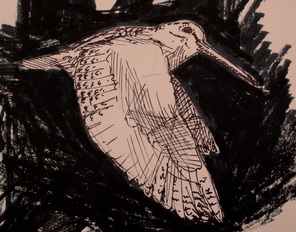 ...On to other things. As I drive across Caroline County every weekday morning, I am finding that at 6:30 am, I can finally once again see the countryside around me. As I head away from home, the sky begins to change from deep purple to streaks of red and orange. Driving down River Road has become a treat over the past few days, as the tide is low in the Choptank each morning right now, and the orange glow reflecting off of the flats is breathtaking through silhouetted trees. I will have to paint it soon. Yesterday, in the dark of early morning and for the second time in a week, I have almost been struck in the face by sex-crazed woodcocks in my backyard. There seem to be a lot of woodcocks in the area this year. I don't recall hearing or seeing this many of the fat little birds in years past. I'll have to see if there is population studies being done, and if this cool little bird is on the upswing. However, why I mention woodcocks again is something I noticed as the birds whizzed past my head. As they approached out of the dark, I heard a weird noise that I had never noticed before. From about five or six feet way, I could distinctly hear the woodcock "chattering" as it flew. I've hear them twitter as they make great circling flights before in their mating display, but this was different. Honesty, each time they passed, it sounded as though the cartoon characters Bevis and Butthead were mumbling to themselves. I've never heard anything like it before. I think this one little thing I've discovered now firmly cements the woodcock as my favorite bird.
1 Comment
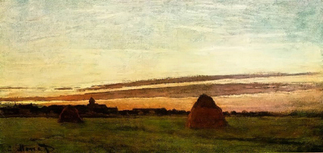 Eduard Monet, Hayricks, 1865 Today, the local weather reports predict snow. The prediction is perfect for next weekend's workshop, in which we'll be painting mallards on ice. The same is predicted for tomorrow and Monday, as well. If it comes, (and that's a big if) this will be our first actual big snow of the 2012-2013 winter. I used to like snow and cold weather, but as I get older, I seem to see less and less that I like about the fluffy white stuff. However, there are a few things that I still find fascinating about the cold covering we expect over the next few days. My favorite thing about snow is how it changes the landscape so dramatically, and how it allows me to reinterpret what I see through my paintings. Being a sometimes-landscape painter, I love the way the changing of seasons and varied conditions allow me to explore how I see and record the effects of color, light and shadow in my watercolors. Monet did this better than anyone. I'm not comparing myself to one of the great impressionists, but I am building from what he and others did as I venture out into the snow, or the sun, or evening dim to paint what I see at the moment. One of Monet's recurring themes and subjects was the effect of seasonal change upon haystacks. He painted hundreds of images of the tall French piles of hay and straw. Every painting was the same yet each was different, each unique. He painted them in early morning light, hazy blue and violet. He painted haystacks in the bright of day, in the spring, in the summer and in the fall. My favorite is the painting to the right, in which he painted several haystacks near nightfall, as the warm late summer sun set behind them. His use of horizontal bands of shadow and light make this painting calm and peaceful. Any modern interpretation of the same image could use his colors, his composition and his ideas, but could do no better. Again, I am not comparing myself to Monet. However, I can make a connection in that I love painting the same subject, under different conditions. Often my landscapes depict the same subject. One of my favorite of these is an old house not far from my studio. The house on Holly Road, between Greensboro and Ridgely, was moved to it's current location from a nearby field years ago. I remember when it was moved, because I never understood why the owner of the house moved it. Since it's relocation the home has stood, abandoned, it's doors and windows boarded shut. Trees have grown up around it, and now it is difficult to find from the road because of the surrounding small pines, brush and vines. I have painted this old place at least a dozen times. Sometimes the paintings have been colorful, but most often the paintings I complete of this particular subject are stark, nearly colorless scenes, making them radically different than Monet's, and closer in feel to many watercolors by Andrew Wyeth. In these two examples, I've used the same view and the same composition to create two glimpses of the same subject. The painting on the left is the old house in winter, The painting on the right is the same view in late fall. In these paintings I spent less time looking at the effect of light and shadow than Monet. Changes in value in these two paintings allow for the finished images to give the feel of seasonal change.
Speaking of seasonal changes and snow, this month's watercolor workshop here at the studio will be a landscape wildlife painting depicting several winter mallard ducks, sitting on an ice shelf in the river. I call it a landscape watercolor because we should plan to paint some environment in the painting, as well as just the waterfowl. We'll be looking not only at how to create the appearance of detail in the birds, but also at how to paint light and shadow on snow. It should be a good experience for new painters and experienced watercolorists. I hope to see you there. Paint something today. The special workshop we had today in the studio, looking at composition to make good-looking watercolor paintings was a great success. We learned about the concepts of design, compositional methods in creating a painting, and planning a soundly put-together watercolor. It looked to me as though everyone who attended learned a lot, and planned some great paintings. While no one finished a painting, a lot of thinking occurred. (actually, very little painting was done, because everyone was so intent upon creating movement in their work, looking for unity and a little variety, and placing their focal point. They just ran out of time. It was a great day! While we were together, one of the participants asked about a workshop on perspective. She complained that she could never make her landscapes look like they had any depth. Last year about this time, we held a perspective workshop here at the studio, and it was very well received. But almost everyone at at today's workshop said that they would love to have another perspective day int he studio. So, I checked the calendar and we scheduled another perspective workshop for April 9th here at Sewell Mills Studio. We spent a lot of time at the last workshop looking mainly at classic linear perspective, using one-point and two-point perspective to make buildings appear to back in space. This time, we're going to do look at linear perspective again, but also spend more time on the ideas of atmospheric, or visual, perspective as well. LINEAR PERSPECTIVE was developed during the early Italian Renaissance, using mathematical principals to allow painters to dive their paintings the illusion of three dimensions. Artists like Perugino created paintings like The Delivery of the Keys (in this case using one-point perspective), almost to show off their new-found understanding of how we see things. When we see paintings like this, we can begin to understand that it is not impossible to make our own work seem to go back in space. Perugino's use of a grid in this painting show us the way to complete our own paintings using his methods. Hopper painted this using two-point perspective to show us a view of the lighthouse at an angle, and from below. At first, as you explore linear perspective, you'll feel the need to lightly draw a horizon line, add vanishing points and carefully render lines before you begin to paint. Soon, however, linear perspective will become second nature. You will find it easier and easier the more you practice.
Atmospheric perspective, however, is not quite so geometric, and easier for some to understand. Atmospheric perspective is just a series of observations that seem to be true in most cases. These observations include, As things go back in space:
Once we understand these observations, we can include these ideas in our work. One of the obvious mistakes I see in so many watercolors is the misuse of the ideas of atmospheric perspective. I'm looking forward to April's workshop. It should be a great refresher for many, and new information for some who attend. I think I'll try my hand at making a video of parts of the day, and posting the video here on my blog. We'll see how it works. See you soon in the studio.  Well, not a good day. I was on the way to a show in Chestertown when my car decided to quickly burst into flames. I had my display system as well as over fifty watercolors loaded in the Dodge Durango when something happened to the drive train, and I had to get out in a hurry. Most of the paintings were at least damaged, and many were completely destroyed. I know I'll have to cancel my next few shows, because I don't have much left. Needless to say, I had to miss the show in Chestertown. I will probably have enough new paintings by spring for regular shows again. Ouch. The Choptank behind the house has calmed, after most of the runs of fish have ended. Yellow Perch, White Perch, Shad, Rockfish and Herring have come and gone (for the most part), and the rush of fishing has dwindled along with the fish.
Human fishermen are the most visible of the river stalkers early in the spring, but a number of different wildlife species also gather as many fish as they can. Down at the river this year I've seen Otters, Mink, Eagles, Ospreys, Great Blue Herons, and Green Herons angling for a meal. The most interesting animal that I've seen so far this year was a Swallow-Tailed Kite, several miles downriver from the studio. An amazing black and white bird with a four-foot wingspan, the Kite is not often seen in Maryland. I guess this one must have been migrating north, and went farther than most of his kind. For whatever reason he was here, I was happy to have witnessed his travels for a few minutes. The tiny white blossoms of Spring Beauties have faded, and right now Columbine, Jack-in-the Pulpit and Pink Lady's Slippers dominate the parade of wildflowers in the woods. Several species of ferns, their fiddleheads uncurling among the leaf litter, are also reappearing after a winter's rest. I'm still hearing the last calls of the White-crowned Sparrows before they head north, and I'm waiting for an Ovenbird's bright call to replace the sparrows as they leave. A pair of bluebirds have nested in a box in the back yard, and some Carolina Wrens have begun calling the shed home, dragging tufts of grass through the crack in the door. I hope they don't build their nest in the lawn mower. In a few weeks, Canoes and Kayaks will begin silently gliding down the river. The season gets in full swing with Paddlefest, set for May 19th near Denton. I'll be showing some of my artwork art Martinak State park on that date. At the same time, hundreds of small, narrow boats will make their way from the shallow waters of Red Bridges to Martinak's wide banks. A lot of fun activities are planned, as well as art displays. I'm looking forward to the day. 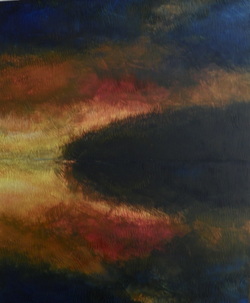 Spring can be seen all over the woods that surround Sewell Mills Studio. Spring Beauties cover the leaf litter down by the river, emerald green Skunk Cabbages have unfurled their leaves in the bog and Bluets are in the meadow. Several pair of brilliantly colored Bluebirds have been checking out all of the nesting boxes, as have a pair of Chickadees. Black and blue Marbled Salamanders can be found moving around among the old piles of firewood that border the woods near the studio. Above, Red Shouldered Hawks call to each other. It is this kind of activity that inspires me to paint, to find new subjects and plan new compositions. This spring, I have been experimenting with Claybord, made by Ampersand. Claybord is a Masonite-type panel, which has been coated with a smooth white clay surface. The clay is absorptive, and may be painted with egg tempera, acrylic, oils or watercolors. I have used Claybord several times to paint images of wildlife, but this spring, I began painting more abstractly with transparent watercolors on the surface. At first, I found it difficult, because I was used to paper. The more I experimented, the more interested in the surface I became. For subjects, I at first chose dark evening images of the river behind my studio. I began painting by pouring liquid watercolors on the surface of the clay. This worked for two reasons: it prepped the surface to accept more paint, and to quickly lay down large areas of color. Then I tried applying color in different ways. I tried scraping, layering with a broad brush, pouring multiple layers and adding multiple layers of scumbled and hatched lines. All of these techniques worked. In at least one painting, I even used masking fluid to reserve whites. As I completed more and more of the paintings, I began varying subjects. Most are still abstract, but several of the paintings on boards are more realistic, at least in part. When the paintings are finished, I cover the completed painting with several layers of varnish to seal the painting. It seems unnatural to seal a watercolor, as far as I was concerned, but now I like the idea, at least on a non-flexible surface like Claybord. Long time since I've posted anything new.... Winter may be waning, and I for one am ready. The snow has mostly missed us here on the eastern shore, but the cold has stayed beyond it's welcome. I can't wait to paint a sprig of forsythia from life as it blooms along the bank by the studio. During one of the many light snows this Winter in Greensboro, my wife Ruth and I watched the sun rise through new fallen snow on the road to the river. The snow clung to every branch and ice covered what snow could not. It was magical. I watched a barred Owl glide silently by us in the half-light as the sun peaked over the hill, heading to a grove of pines. The holly trees by the river cast an emerald glow over the snow by the water. It really was magical. In the studio, I've been experimenting with claybord, a product made of masonite and a thin layer of clay, manufactured by a company called Ampersand. after some fits and starts, I have learned to like the way the surface behaves with watercolors. At first, the paint resists the clay surface but after an initial wash the manner in which the paint can be lifted and moved about is really interesting. Like egg tempera, watercolor on claybord can go back and forth between lights and darks, opaques and transparent layers. I'm also looking more deeply at combining very quick, loose effects with extreme detail in my pieces on paper. The more of these I complete, the more I like the effects. On the surface these paintings look simple, but making the transition from loose brushy strokes to photorealism takes some thought. I do love the results. When I finish a painting that combines these two techniques, and do it right, the paper just feels right. I have to do more of these. See you in the studio soon! Greenbriar Dweller, 16" x 20" by Kurt Plinke. Watercolor on Claybord
Holy Cow was it hot in Easton today. I was there for a one-day outdoors exhibition of arts and crafts, in conjunction with the Easton Plein Air Arts Festival. The bank thermometer said that it was 107 degrees and I, for one, believe it. The trees were steaming in the little park across from Clay Bakers, but that did not deter the crowds who were in town for the festival.
Un the morning, the annual Quick Draw fast painting competition took place, and there were oil painters surrounding us as we set up for the exhibition. About twenty artists and craftspeople set up in the park. I had a good day. Sales were slow, but I saw and talked to a number of students of mine, past and present. It was fun seeing Barb, Judy and the others in a setting outside of a classroom or studio. I also met with several people who said that they would like to try painting in the studio on Tuesday night. Of course, they are invited, and I hope that they sho up soon. It's always fun seeing new painters in the group on Tuesday. In the end, a painting was of mine This is the 17th year that I have participated in the annual Friends of Patuxent art show, at the National Wildlife Visitor's Center, on the grounds of the Patuxent Wildlife refuge, near Washington, DC. The show is on Saturday and Sunday, at the visitor's center.
The Patuxent show is one of my favorite events every year. The facility is a great venue for a show, and the FOP volunteers are a wonderful group. If you have a chance, come on over and see the show. It's been a while since I've entered on this blog. Today, we're all stuck inside and my workshop, set for today, has been rescheduled, so I guess I have a little time. We are really getting snow here at the studio, and across the Eastern Shore. We are expecting at least fifteen inches of snow today, and the winds are supposed to kick up to near blizzard conditions later in the afternoon. These kinds of snows, ones that come up the coast from the south, are the real snow-droppers in our area. Nor'easters, they are called, and when they slow down over our area, we can really get dumped on. It looks like this is going to be one of those days. I always think about small birds on days like today. All of their food sources are buried deep beneath a thick layer of snow. I've already gone out once to fill the feeders in my backyard, and a huge number of birds are using the feeders, despite the wind and snow. So far, I've mainly been bringing in White-throated Sparrows, Juncos, Song Sparrows, House Finches, Cardinals, Chickadees, Titmice, Red-Bellied Woodpeckers and Blue Jays. I expect an influx of doves and blackbirds as the day goes on. A Cooper's Hawk has been scoping out the feeders, too. I imagine that by tomorrow, there will be poofs of feathers under the trees near the feeders. I guess that Coops have gotta eat, too. With any luck I'll settle in, stay warm, watch the feeders and paint for the next few days. A chickadee at one of my window feeders.
|
What's News?Kurt Plinke: About Life, Art and the Nature of Things on the Eastern ShoreI write about things I've noticed, places I've been, plans I've made and paintings I've finished or am thinking about. Archives
February 2020
See recent naturalist observations I have posted on iNaturalist:
|
|
Sewell Mills Studio & Gallery
14210 Draper's Mill Road Greensboro, MD 21639 (410) 200-1743 kurtplinke@kurtplinke.com |
Rights to all images on this website, created by Kurt Plinke, remain the property of Kurt Plinke. Copying or use of these images is permissible only following written permission from Kurt Plinke. To use images for any purpose, contact kurtplinke@kurtplinke.com for permission.
